
Radiant Silvergun is a shoot 'em up video game developed and published by Treasure. It was originally released in Japanese arcades in 1998 and subsequently ported to the Sega Saturn later that year. The story follows a team of fighter pilots in the far future who are battling waves of enemies summoned by a mysterious crystal dug up from the Earth. The player hosts an arsenal of six different types of shots to choose from, and a sword to destroy nearby targets. The stages are tightly designed to present players with scenarios that can be approached differently with the various weapon types.

Virtua Cop is a 1994 light gun shooter game developed by Sega AM2 and designed by Yu Suzuki. It was originally an arcade game on the Sega Model 2 system, and was ported to the Sega Saturn in 1995 and Windows in 1996. The Saturn version included support for both the Virtua Gun and Saturn mouse, as well as a new "Training Mode" which consists of a randomly generated shooting gallery.
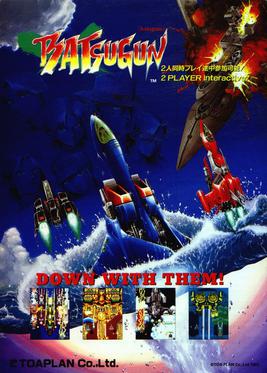
Batsugun is a 1993 vertically scrolling bullet hell arcade video game originally developed and published by Toaplan in Japan and Europe by Taito, as well as Korea by Unite Trading. The last shoot 'em up created by Toaplan, the title takes place on a distant Earth-like planet where a global takeover operative led by king Renoselva A. Gladebaran VII is set into motion, as players assume the role from one of the six fighter pilots conforming the Skull Hornets squadron taking control of submersible jets in a last-ditch effort to overthrow the invading military force from the planet. Its gameplay mainly consists of shooting mixed with role-playing game-esque elements using a main two-button configuration.
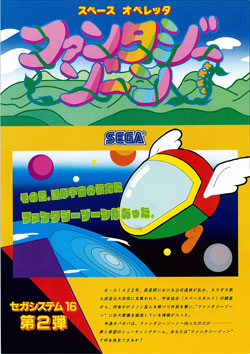
Fantasy Zone is a 1986 arcade video game by Sega, and the first game in the Fantasy Zone series. It was later ported to a wide variety of consoles, including the Master System. The player controls a sentient spaceship named Opa-Opa who fights an enemy invasion in the titular group of planets. The game contains a number of features atypical of the traditional scrolling shooter. The main character, Opa-Opa, is sometimes referred to as Sega's first mascot character.

Virtua Cop 2 is a light gun shooter arcade game, released in 1995 and developed internally at Sega by their AM2 studio. It was ported to the Sega Saturn in 1996, PC in 1997, and Sega Dreamcast in 2000. It was bundled with Virtua Cop in Virtua Cop: Elite Edition for PlayStation 2 in 2002.

Die Hard Arcade, known as Dynamite Deka in Japan, is an arcade beat 'em up video game released by Sega. It was the first beat 'em up to use texture-mapped 3D polygon graphics, and used a sophisticated move set by contemporary beat 'em up standards, often being likened to a fighting game in this respect. It also features quick time events, the ability to combine items to make more powerful weapons, and in two-player mode the ability to perform combined special moves and combos.

Captain America and the Avengers is a beat 'em up arcade game developed and released by Data East in 1991. It features the Avengers team of Marvel Comics characters in a side-scrolling brawling and shooting adventure to defeat the evil Red Skull. The game received ports for the Sega Genesis/Mega Drive, Super Nintendo Entertainment System, Game Boy and Game Gear. A different Data East game was released for the Nintendo Entertainment System.

RayForce is a vertically scrolling shooter by Taito for the Taito F3 arcade hardware and released in 1994. It was ported to the Sega Saturn in 1995, Microsoft Windows in 1997, then rereleased for iOS in 2012 and Android in 2017.
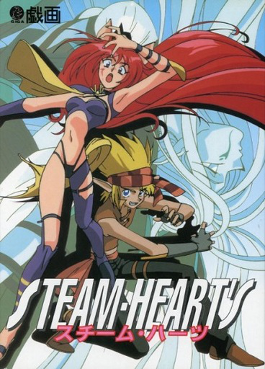
Steam-Heart's is a vertically scrolling shooter and eroge developed by Giga and published by TGL. The story follows two siblings as they fight off a virus that is possessing the people in their world. The game features shooter gameplay paired with ample erotic cutscenes with scantily clad women. Steam-Heart's was initially released on PC-98 personal computers in 1994. It was released for the PC Engine Super CD-ROM² System in 1996 and then the Sega Saturn in 1998. All releases have been limited to the Japanese market. Critics generally found the gameplay to be average, with the erotic content being the sole distinguishing feature.

DonPachi is a 1995 vertical-scrolling shooter arcade game developed by Cave and published by Atlus in Japan. Players assume the role of a recruit selected to take part in a secret military program by assaulting enemy strongholds in order to become a member of the "DonPachi Squadron".

Twin Cobra II is a vertically scrolling shooter arcade video game developed by Takumi Corporation and published in 1995 by Taito in Japan, Asia and Europe. It is the sequel to Twin Cobra from 1987. Taking place after the events of the previous game, players assume the role of two pilots taking control of their respective attack helicopters to overthrow the returning enemy forces.
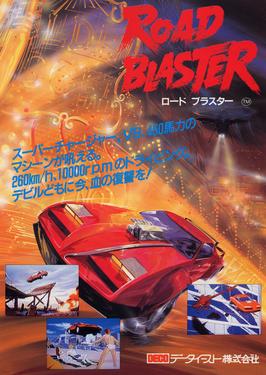
Road Blaster (ロードブラスター) is an interactive movie video game developed by Data East featuring animation by Toei Animation, originally released exclusively in Japan as a laserdisc-based arcade game in 1985. The player assumes the role of a vigilante who must avenge the death of his wife by pursuing the biker gang responsible for her death in a modified sports car. The game would later be ported to a variety of home formats such as the MSX and Sharp X1, Sega CD, LaserActive, PlayStation and Sega Saturn. The Sega CD and Mega-LD versions were released outside of Japan under titles of Road Avenger and Road Prosecutor respectively.

Astra Superstars (アストラスーパースターズ) is a 1998 2D versus fighting arcade game illustrated and designed by Santaclaus, developed and published by Sunsoft, and distributed by Tecmo in Japan on June 6, 1998. It is Sunsoft's fourth fighting game after the 1994 Super Famicom Hebereke franchise spin-off Sugoi Hebereke, the 1995 Galaxy Fight: Universal Warriors and the 1996 Waku Waku 7. It is powered by the Sega Saturn-based ST-V arcade system. Astra Superstars is an airborne-based fighting game.
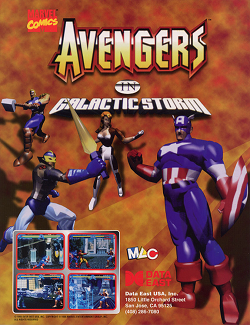
Avengers in Galactic Storm (アベンジャーズ・イン・ギャラクティックストーム) is a 1995 fighting arcade game developed and published by Data East. It features a single or two-player story mode or multiplayer head-to-head mode, and was the first modern fighting game to feature assistant characters commonly referred to by gamers either as "helpers" or "strikers". The game is based on characters in the Marvel universe, primarily The Avengers but also the Kree. The game's plot and roster of playable characters is based on the Operation: Galactic Storm story arc. Before their bankruptcy in 2003, it was one of Data East's last fighting games, as well as their third and last game based on The Avengers after their two 1991 video games: the Captain America and The Avengers beat 'em up arcade and the NES platform game of the same name.

Atomic Runner Chelnov is a Japanese runner arcade video game developed and published by Data East in 1988.
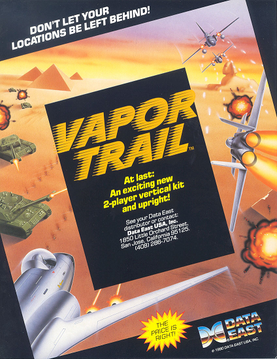
Vapor Trail: Hyper Offense Formation, known in Japan as Kuuga – Operation Code Vapor Trail and usually simply referred to as Vapor Trail, is a 1989 shoot 'em up arcade game developed and published by Data East. Vapor Trail was followed by Rohga: Armor Force and Skull Fang.

Gekirindan is a 1995 vertically scrolling shooter arcade video game originally developed and published by Taito in Japan, America and Europe. Set in the year 3195, where a robot known as "Huge Boss" stole a newly developed time machine to travel back in time and rewrite human history, players assume the role of one of the six fighter pilots taking control of their own space fighter craft in an effort to overthrow the evil entity from altering history.

Rohga: Armor Force, released in Japan as Wolf Fang: Kuuga 2001, is a 1991 run and gun/platform hybrid arcade game developed and published by Data East. It is related to Vapor Trail and was itself followed by Skull Fang.

Ragnagard is 2D arcade fighting game developed by Saurus and System Vision, and published by SNK and Saurus for the Neo Geo arcade, Neo Geo CD and Sega Saturn. The game's characters are all based on Shinto deities.
Sky Target is a 1995 arcade game by Sega. A rail shooter featuring a number of planes including the default F-14D Super Tomcat, it is best remembered for its semi-official connection to Sega's earlier hit After Burner. Although never billed as a sequel, its overt similarities to the 1987 classic were nonetheless referenced in official promotional materials and recognized by the media. Plus, it features a revised version of the "After Burner" music theme within its soundtrack.















